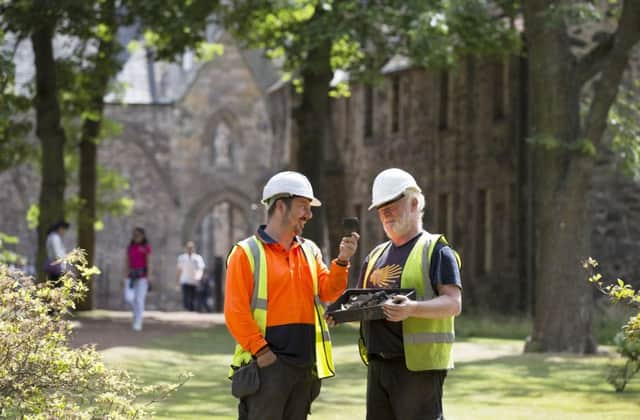Archeologists uncover 12th century treasure trove at Holyroodhouse


Other artefacts include a medieval shoe, a 300-year-old smoking pipe and part of a 12th-century jug.
Experts say the pieces represent a time capsule of life in Edinburgh through the ages.
Advertisement
Hide AdAdvertisement
Hide AdMost of the finds were discovered in or around the Abbey Strand buildings in the Canongate, which are among the oldest surviving structures in the Scottish capital.
They were revealed during archaeological investigations being carried out as part of a £10 million overhaul of facilities at the palace.
Digs have revealed timber posts dating back to the 12th century, representing the earliest evidence of settlement on the site.
It’s thought they may mark the location of a terrace that led to what was once a low-lying island, on which Holyrood Abbey was built in 1128.
Bones of Highland cattle found in the Abbey Strand gardens provide evidence of trading between Edinburgh and the Highlands and Western Isles.
Other animal bones, a large quantity of oyster shells and fragments of wine bottles give an insight into the diets of courtiers and ambassadors who stayed at the royal residences during the reigns of Mary, Queen of Scots and King James VI. One of the oldest finds is a medieval leather shoe, discovered beneath one of the cellars in the Abbey Strand.
Wine and spirit bottles, food debris and fragments of children’s games stem from the 18th and 19th centuries, providing a glimpse of life for 25 impoverished families living in cramped tenements at Holyrood at the time.
Investigations in the palace grounds found evidence of how the site has changed through the centuries, from the flower gardens and orchards of the 12th-century monastery to formal gardens during the time of Mary, Queen of Scots and a physic garden that inspired the Royal Botanic Garden Edinburgh.
Advertisement
Hide AdAdvertisement
Hide AdPottery remnants uncovered include part of a 12th-century green-glazed jug, which was imported from Europe.
A clay pipe dating from the 17th century bears the initials of one of Scotland’s earliest pipe-makers.
Among the more unusual discoveries is the complete skeleton of a horse, uncovered under the lawn next to the palace forecourt. This area was close to the site of a medieval graveyard serving the Canongate, but when and why the animal was buried there remains a mystery.
Gordon Ewart, of Kirkdale Archaeology, which led the dig, said: “The survey has provided a unique opportunity to understand more about the fascinating development of the Abbey Strand and its surroundings, and to explore how the site has been the historic and symbolic bridge between the palace and the city of Edinburgh for centuries.”
Holyrood was first founded as an Augustinian abbey in 1128. According to legend, it was built on the spot where King David I had a religious vision while out hunting deer on Holy Cross Day.
After Edinburgh became the capital of Scotland in 1437, successive monarchs opted to stay in the royal chambers at the abbey rather than at the less comfortable castle a mile up the road. This sparked numerous developments and additions over the years.
Today the Palace of Holyroodhouse is the Queen’s official residence in Scotland, but it has a colourful history going back several centuries.
It was in its tower that Mary, Queen of Scots witnessed the brutal murder of her Italian secretary and rumoured lover at the hands of her husband.
Advertisement
Hide AdAdvertisement
Hide AdRobert the Bruce hosted parliament there in 1326; it was occupied by Oliver Cromwell in 1650 during the civil war; and Bonnie Prince Charlie held court at the palace during his 1745 bid to restore the Catholic line to the British throne.